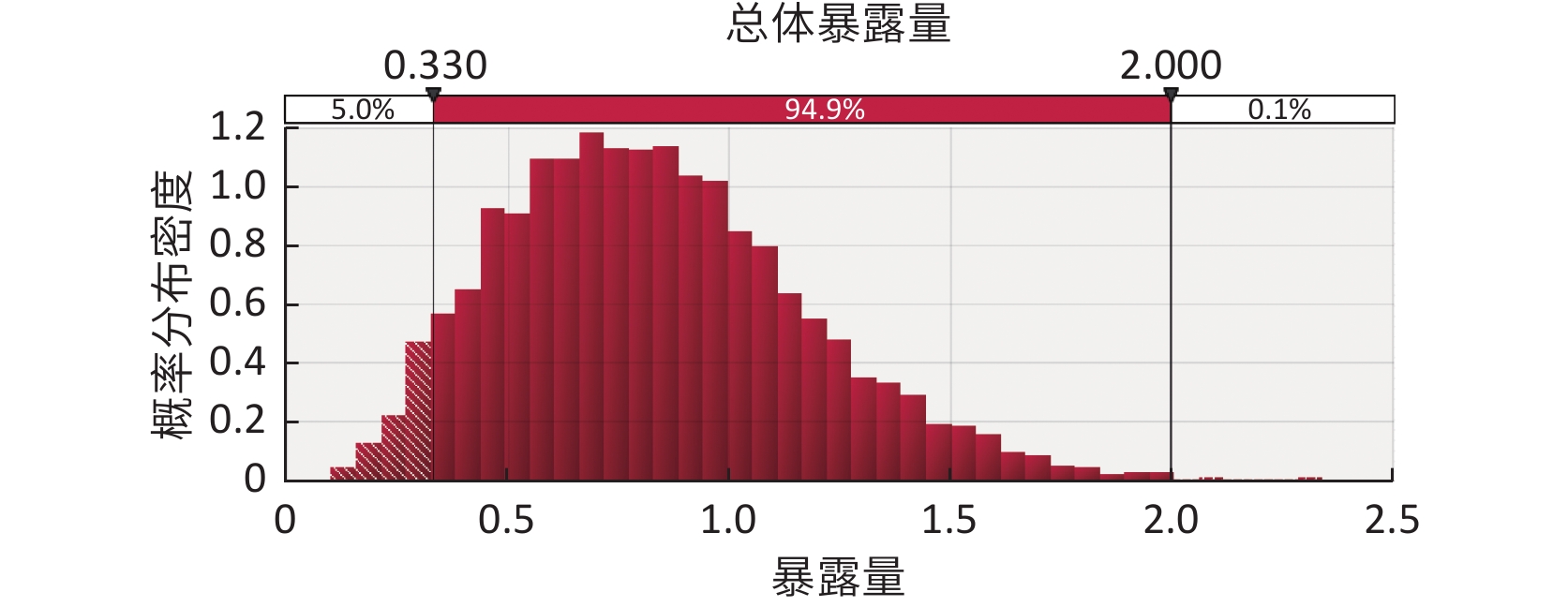Risk assessment of dietary exposure to 3-monochloropropane-1,2-diol esters in infant formula powders in Shanghai
-
摘要:背景
氯丙醇酯是近年来受到广泛关注的新型污染物,主要在植物油精炼过程中产生,其中以3-氯丙醇酯(3-MCPDE)污染问题最为突出,其在生物体内水解生成3-氯丙醇,已被证实具有生殖毒性、肾脏毒性及潜在致癌性。婴幼儿配方乳粉生产加工过程中添加精炼植物油的同时会引入氯丙醇酯污染。
目的了解上海市售0~3岁婴幼儿配方乳粉中3-MCPDE污染状况及婴幼儿配方乳粉的消费情况,科学评估婴幼儿配方乳粉中3-MCPDE污染与健康风险。
方法采用气相色谱-质谱法测定133件上海市采集的市售婴幼儿配方乳粉中3-MCPDE污染水平。采用多阶段分层随机抽样的方法,从上海各区街道/乡/镇内随机抽取0~3岁婴幼儿共807人作为调查对象,包括0~6月龄婴幼儿208人、6~12月龄婴幼儿276人和12~36月龄婴幼儿323人。运用食物频率表法,采用线上电话询问、线下现场面对面调查相结合的方式,对婴幼儿监护人开展问卷调查,调查婴幼儿配方乳粉的消费水平。建立暴露量评估模型计算3-MCPDE暴露量,应用@Risk 7.5软件并根据Monte Carlo原理模拟计算,获得0~3岁婴幼儿的3-MCPDE暴露水平概率分布。结合欧洲食品安全局(ESFA)提出的3-MCPDE的每日可耐受摄入量2.00 μg·(kg·d)−1,对上海市0~3岁婴幼儿经婴幼儿配方乳粉摄入3-MCPDE进行暴露风险评估。
结果133件0~3岁婴幼儿配方乳粉中,3-MCPDE检出平均值为0.115 mg·kg−1,检出率为100.00%。0~6月龄配方乳粉中3-MCPDE质量分数(后简称为浓度)及脂肪浓度均最高,平均值分别为0.136 mg·kg−1和25.2 g(每100 g样品计)。相关性结果显示,样本中脂肪浓度与3-MCPDE浓度之间存在正相关关系(
r =0.438,P <0.05)。807位0~3岁婴幼儿对婴幼儿配方乳粉的消费量平均值为88.3 g·d−1;0~6、6~12以及13~36月龄婴幼儿对婴幼儿配方乳粉消费量平均值分别为87.7、98.3和80.1 g·d−1。经模拟计算得到上海市0~3岁婴幼儿经婴幼儿配方乳粉摄入3-MCPDE的一般水平(以平均值来衡量)和高摄入水平(以第95百分位值来衡量)分别为0.83、1.44 μg·(kg·d)−1。随着月龄的增加,暴露量递减,0~6月龄婴儿的暴露量最大,其一般摄入水平及高摄入水平分别为1.41、2.34 μg·(kg·d)−1。健康风险评估结果显示,0 ~6月龄婴幼儿和6~ 12月龄婴幼儿分别有13.90%和0.50%的概率因摄食婴幼儿配方乳粉而导致3-MCPDE的暴露水平超出ESFA推荐的每日可耐受摄入量,其健康受损风险不容忽视,12~36月龄婴幼儿的暴露水平尚无相关健康风险。结论上海市0~3岁婴幼儿中,0 ~6月龄婴幼儿对婴幼儿配方乳粉中3-MCPDE存在较高暴露风险。鉴于婴幼儿对污染物暴露的敏感性,需予以高度关注。
Abstract:BackgroundChloropropanol esters (MCPDE) have attracted much attention in recent years as a kind of new contaminant found in various refined oils. The pollution of 3-monochloropropane-1,2-diol esters (3-MCPDE) is the most prominent. 3-MCPDE is hydrolyzed in organisms to 3-monochloropropane-1,2-diol which has been shown to have reproductive toxicity, nephrotoxicity, and potential carcinogenicity. Infant formula powders can be polluted by 3-MCPDE when refined edible oils are added during production.
ObjectiveTo assess the risk of exposure to 3-MCPDE related to the consumption of infant formula powders for children aged 0-3 years in Shanghai market using the food consumption data and the data of 3-MCPDE contamination in these foods.
MethodsGas chromatography-mass spectrometry was used to determine 3-MCPDE in 133 samples of infant formula powders in Shanghai. Using a multistage stratified random sampling method, a total of 807 infants and toddlers aged 0-3 years were randomly selected from each district/rural/town in Shanghai, including 208 children aged 0-6 months, 276 children aged 6-12 months, and 323 children aged 12-36 months. The food consumption data was investigated using food frequency questionnaire (FFQ) distributed by combining telephone inquiries and face-to-face interviews among guardians. Population's probability distributions of 3-MCPDE exposure were assessed by @Risk 7.5 software and Monte Carlo simulation algorithm. According to the dietary intake assessment model and the tolerable daily intake (TDI) of 3-MCPDE of 2.00 μg·(kg·d)−1 proposed by the European Food Safety Authority (ESFA), a risk assessment of exposure to 3-MCPDE was conducted for infants and toddlers aged 0 to 3 years old in Shanghai who consumed 3-MCPDE via infant formula powders.
ResultsThe average concentration of 3-MCPDE in 133 samples of infant formula powders was 0.115 mg·kg−1 with a positive rate of 100.00%. Among different types of formula powders, infant formula powders for infants of 0-6 months had the highest concentrations of 3-MCPDE and fat [0.136 mg·kg−1 and 25.2 g (per 100 g sample) in average respectively]. There was a positive correlation between fat concentration and 3-MCPDE concentration in the samples (
r =0.438,P <0.05). The average consumption of infant formula powders of 807 infants aged 0-3 years was 88.3 g·d−1. Among all investigated age groups, the average consumption of infant formula powders by infants aged 0-6, 6-12, and 12-36 months was 87.7, 98.3, and 80.1 g·d−1 respectively. The dietary exposure to 3-MCPDE from infant formula powders of infants aged 0-3 years averaged 0.83 μg·(kg·d)−1 for general intake level or valued 1.44 μg·(kg·d)−1 using the 95 percentile for high intake level. Exposure decreased with increasing age and was highest in infants 0-6 months of age, whose general and high intake levels were 1.41 and 2.34 μg·(kg·d)−1, respectively. The risk population defined with the exposure higher than the TDI proposed by EFSA were proportioned to be 13.90% and 0.50% in infants aged 0-6 months and 6-12 months respectively, indicating a risk that cannot be ignored, and no risk in infants aged 12-36 months.ConclusionAmong the investigated infants aged 0-3 years in Shanghai, those aged 0-6 months are at a high risk of exposure to 3-MCPDE. In view of the sensitivity of infants to pollutant exposure, the risk of exposure to 3-MCPDE should be highly concerned.
-
氯丙醇酯是一种食品生产及加工过程中的污染物,在食用油脂及其加工食品中含量较高,包括3-氯丙醇酯(3-monochloropropane-1,2-diol esters, 3-MCPDE)、2-氯丙醇酯、1,3-二氯-2-丙醇脂肪酸酯和2,3-二氯-1-丙醇脂肪酸酯,其中以3-MCPDE污染问题最为突出[1]。3-MCPDE在生物体内脂肪酶的作用下可生成水解产物3-氯丙醇(3-monochloropropane-1,2-diol, 3-MCPD),具有生殖毒性、肾脏毒性及潜在致癌性[2]。2006年,联合国粮农组织和世界卫生组织下的食品添加剂联合专家委员会(Joint FAO/WHO Expert Committee on Food Additives, JECFA)把3-MCPDE加入优先评价化合物名单[3]。
婴幼儿配方乳粉生产加工过程中添加精炼植物油的同时会引入氯丙醇酯污染。2007年,德国联邦风险评估研究所率先对婴幼儿配方乳粉中的3-MCPDE进行了评估,结果表明婴幼儿经配方乳粉摄入的3-MCPDE的健康风险较高[4]。婴幼儿是污染物暴露的敏感人群,且配方乳粉作为母乳替代品,已成为全球半数以上婴幼儿膳食及营养的主要来源[5],通过婴幼儿配方乳粉摄入3-MCPDE引起健康危害的风险不容忽视。本研究拟了解上海市售0~3岁婴幼儿配方乳粉中3-MCPDE污染状况及婴幼儿配方乳粉的消费情况,科学评估婴幼儿配方乳粉中3-MCPDE污染与暴露风险。
1. 对象与方法
1.1 污染状况调查
1.1.1 样品来源
2018—2020年间在上海市采集市售婴幼儿配方乳粉样品共133件,包括婴儿配方粉(1段,0~6月龄)44件、较大婴儿配方粉(2段,6~12月龄)42件以及幼儿配方粉(3段,12~36月龄)47件。综合考虑上海市居民食品消费环节、消费习惯等因素,采样点覆盖各区域大中型超市、品牌实体专卖店和网店,样品涉及32个常见婴幼儿配方乳粉品牌。样品以国产为主,国产样品88份,产地覆盖国内14个省市区;海外产地样品45份。
1.1.2 检测方法
参照国家食品安全风险评估中心《2017年国家食品污染物和有害因素风险监测工作手册》中“食品中脂肪酸氯丙醇酯和缩水甘油酯总量测定的标准操作程序(第一法)”,采用气相色谱-质谱法测定婴幼儿配方乳粉中3-MCPDE。
1.2 消费量调查
1.2.1 调查对象
以0~3岁婴幼儿作为目标人群,采用多阶段分层随机抽样的方法,按经济水平、地理位置等因素,对上海市常住户籍人口开展抽样调查。2021年从上海各区街道/乡/镇内随机抽取0~3岁婴幼儿共807人作为主要调查对象,未食用对应月龄段配方食品的调查对象已剔除。根据GB 10765—2021《食品安全国家标准 婴儿配方食品》、GB 10766—2021《食品安全国家标准 较大婴儿配方食品》、GB 10767—2021《食品安全国家标准 幼儿配方食品》中婴幼儿乳粉月龄段区间划分,调查对象包括0 ~6月龄婴幼儿208人、6 ~12月龄婴幼儿276人和12 ~36月龄婴幼儿323人。
1.2.2 调查方法
采用统一设计的调查问卷,应用食物频率表法,由经培训的调查员通过线上电话询问、线下现场面对面调查相结合的方式,对婴幼儿监护人开展问卷调查,调查内容包括婴幼儿基本信息(性别、月龄、身高、体重等)、婴幼儿配方乳粉消费水平(消费频率、消费量等),本研究已通过上海市疾病预防控制中心伦理审查委员会的伦理审查(编号:2022-50)。调查对象的监护人签署知情同意书。
1.3 暴露量评估
采用联合国粮农组织和世界卫生组织推荐的食品化学物质膳食暴露评估方法[6],建立暴露量评估模型,每天每千克体重暴露量=∑(食品中污染量×校正系数×加工因子×每天食品消费量)/体重。本研究采集的食品样品均为即食食品,不涉及食品烹调、加工等影响因素,研究中直接以样品中3-MCPDE污染量进行计算,故校正系数与加工因子均取常数1。根据暴露量评估模型,运用@Risk 7.5分析软件,分别对婴幼儿配方乳粉中3-MCPDE污染量、0~3岁婴幼儿体重及每日消费量数据进行分布拟合。其中,污染量数据选择拟合后的最优函数分布,符合Triang分布,婴幼儿体重及配方乳粉消费量符合正态分布。根据Monte Carlo原理进行10000次非参数模拟,抽样方法设定为拉丁超立方抽样,分别以平均值和第95百分位值作为一般摄入水平和高摄入水平[7]。
1.4 暴露风险评估
目前,对于3-MCPDE的暴露风险评估,都是基于其在人体肠道中会完全水解为3-MCPD的假设,并根据3-MCPD的毒理学数据开展的[8]。2018年,欧洲食品安全局(European Food Safety Authority, ESFA)基于JECFA发布的3-MCPD最新发育和生殖毒性数据及研究[9],以引起10%的实验雄性大鼠肾小管增生的基准剂量可信下限值作为最新参考点,制定3-MCPDE的每日可耐受摄入量为2.00 μg·(kg·d)-1[10]。
本研究将上海市0~3岁婴幼儿每日暴露量与上述每日可耐受摄入量比较,进行风险评价。当暴露量高于该参考剂量时,则认为存在暴露风险。
1.5 统计学分析
数据经Microsoft Excel 2003录入,采用SAS 9.1.3进行统计分析。均数的比较采用ANOVA方差分析,两两比较采用SNK法。相关性分析采用Pearson相关。检验水准α=0.05。
2. 结果
2.1 婴幼儿配方乳粉中3-MCPDE污染状况
市售的133件0~3岁婴幼儿配方乳粉中均检出3-MCPDE,检出率高达100.00%,3-MCPDE质量分数(后简称为浓度)范围为0.026~0.217 mg·kg−1,平均浓度为0.115 mg·kg−1。不同月龄段配方粉中3-MCPDE浓度差异存在统计学意义(F=10.274,P <0.05),以0~6月龄配方乳粉中3-MCPDE浓度最高,平均值为0.136 mg·kg−1。不同月龄段配方乳粉的脂肪浓度差异也存在统计学意义(F=76.012,P<0.05),0~6月龄配方乳粉脂肪浓度最高,每100 g样品中平均值为25.2 g。见表1。
表 1 2018—2020年上海市售0~3岁婴幼儿配方乳粉中3-MCPDE和脂肪浓度Table 1. 3-MCPDE and fat concentrations in infant formula powders for infants of 0-3 years in Shanghai from 2018 to 2020分类 n 脂肪浓度/g
(每100 g样品计)3-MCPDE浓度/(mg·kg−1) $ \bar x $ 范围 P50 P95 婴儿配方乳粉
(0~6月龄)44 25.2 0.136 0.036~0.217 0.133 0.200 较大婴儿配方乳粉
(6~12月龄)42 20.7 0.106 0.026~0.194 0.099 0.175 幼儿配方乳粉
(12~36月龄)47 18.7 0.102 0.037~0.186 0.097 0.169 合计 133 21.5 0.115 0.026~0.217 0.106 0.190 进一步开展相关性结果显示,样本中脂肪浓度与3-MCPDE浓度之间存在正相关关系(r=0.438,P<0.05)。
2.2 婴幼儿配方乳粉消费水平
807位0~3岁婴幼儿对婴幼儿配方乳粉的消费量平均值为88.3 g·d−1,中位数为94.6 g·d−1,第95百分位数为150.0 g·d−1。按照月龄段分析,0~6、6~12以及12~36月龄婴幼儿的平均体重分别为6.7、9.8和13.3 kg,其对应婴幼儿配方乳粉消费量平均值分别为87.7、98.3和80.1 g·d−1。见表2。
表 2 不同月龄段婴幼儿对婴幼儿配方乳粉的消费量Table 2. Consumption of infant formula powders by age groups单位:g·d−1 婴幼儿分组 n $ \bar x $ P50 P95 0~6个月 208 87.7 90.0 150.0 6~12个月 276 98.3 100.0 160.0 12~36个月 323 80.1 75.0 141.7 合计 807 88.3 94.6 150.0 2.3 婴幼儿配方乳粉中3-MCPDE暴露量评估
经模拟计算得到上海市0~3岁婴幼儿经婴幼儿配方乳粉摄入的3-MCPDE暴露水平(以平均值来衡量)为0.83 μg·(kg·d)−1,高摄入水平(以第95百分位值来衡量)为1.44 μg·(kg·d)−1。不同月龄段婴幼儿经婴幼儿配方乳粉摄入的3-MCPDE暴露量概率分布也有所不同,0~6、6~12以及12~36月龄婴幼儿3-MCPDE暴露量平均值分别为1.41、0.92、0.56 μg·(kg·d)−1(表3)。随着月龄的增加,婴幼儿经婴幼儿配方乳粉的3-MCPDE暴露量有递减的趋势,0~6月龄婴儿的暴露量最大。
表 3 不同月龄段婴幼儿经婴幼儿配方乳粉摄入的3-MCPDE暴露量分布Table 3. Percentiles of 3-MCPDE intake from infant formula powders by age groups单位:μg·(kg·d)−1 婴幼儿分组 $ \bar x $ P5 P25 P50 P75 P95 0~6月龄 1.41 0.63 1.02 1.37 1.75 2.34 6~12月龄 0.92 0.39 0.65 0.88 1.15 1.59 12~36月龄 0.56 0.26 0.40 0.53 0.69 0.93 合计 0.83 0.33 0.58 0.80 1.04 1.44 2.4 婴幼儿配方乳粉中3-MCPDE暴露的健康风险评估
根据暴露量概率评估结果,以3-MCPDE的每日可耐受摄入量2.00 μg·(kg·d)−1为参考剂量,0~3岁婴幼儿中有99.9%的婴幼儿经婴幼儿配方乳粉摄入3-MCPDE的水平低于2.00 μg·(kg·d)−1,即0~3岁婴幼儿有0.1%的概率因摄食婴幼儿配方乳粉而接触3-MCPDE,导致存在健康风险。见图1。
根据不同月龄段暴露量开展健康风险评估,0~6和6~12月龄的婴幼儿分别有13.90%和0.50%的概率因摄食婴幼儿配方乳粉而接触3-MCPDE,导致存在健康风险;12~36月龄婴幼儿尚无相关健康风险。
3. 讨论
婴幼儿配方乳粉中氯丙醇酯的污染主要来源于其精炼植物油原料。近年来,婴幼儿配方乳粉中氯丙醇酯污染及引发的健康风险日益受到关注。欧洲食品安全局在2016年提出婴幼儿配方粉(粉状)中3-MCPDE的建议限量值0.125 mg·kg−1,同时开展的相关风险评估结果显示,对于以婴幼儿配方乳粉为唯一膳食来源的婴幼儿而言,其3-MCPDE的一般暴露水平和高暴露水平分别为2.40和3.20 μg·(kg·d)−1[11]。JECFA于2017年发布第83次会议报告中,收集了全球各地区对于3-MCPDE的相关评估结果,其中美国不同月龄段婴幼儿对婴幼儿配方乳粉中3-MCPDE的一般暴露水平和高暴露水平达到7~10 μg·(kg·d)−1和21~25 μg·(kg·d)−1,并分析可能与美国婴幼儿配方乳粉大多以棕榈油为原料有关;日本、加拿大地区婴幼儿的3-MCPDE一般暴露水平为5 ~7 μg·(kg·d)−1[9]。我国国家食品安全风险评估中心研究显示,2015年以进食婴儿乳粉为主的6月龄婴儿的3-MCPDE一般暴露水平和高暴露水平为0.30和1.74 μg·(kg·d)−1[12]。我国北京、杭州地区2020年以来开展的相关评估结果显示,0~3岁婴幼儿3-MCPDE的一般暴露水平在0.27 ~2.50 μg·(kg·d)−1之间,高暴露水平在0.87 ~4.30 μg·(kg·d)−1之间[13-15]。
本次婴幼儿配方乳粉中3-MCPDE暴露评估采用概率评估的方法,应用@Risk软件反复模拟计算上万次得到暴露水平的概率分布,很大程度上降低了极值的影响。另外,对于3-MCPDE的健康风险评估引用了国际权威机构推荐和被广泛使用的参数和模型,评估结果具有较好的科学性和可比性,直观反映出本市0~3岁婴幼儿经婴幼儿配方乳粉摄入3-MCPDE所带来的健康风险。与国内外相关研究结果相比,本次研究中上海市0~3岁各月龄段婴幼儿在婴幼儿配方乳粉中3-MCPDE的暴露水平均低于欧美国家评估结果[9],与我国北京、杭州等地区婴幼儿暴露水平相当[13-15],且各月龄暴露水平趋势一致,月龄越小,3-MCPDE暴露水平越高。
由于毒理学研究数据不足,目前国内外对于婴幼儿配方乳粉中氯丙醇酯的污染及暴露风险评估大多仅计算了3-MCPDE的暴露,未考虑2-氯丙醇酯等其他氯丙醇酯及缩水甘油酯转化为3-MCPD的可能,在一定程度上导致风险的低估。
本研究结果显示,上海市0~3岁婴幼儿配方乳粉中3-MCPDE平均浓度为0.115 mg·kg−1,已接近EFSA提出建议限量值(0.125 mg·kg−1)[11],0 ~6月龄段配方乳粉检出浓度超出建议限量值的比例达59.1%。同时,暴露评估结果显示0~6月龄段婴幼儿有13.90%的概率因摄食婴幼儿配方乳粉而接触3-MCPDE,导致存在健康风险。鉴于婴幼儿是污染物暴露的敏感人群,尤其是0~6月龄的婴儿,其身体机能各项发育都不完善,极易受到污染物的影响而造成不可逆转的健康危害,婴幼儿配方乳粉中氯丙醇酯的污染及健康风险应引起足够重视,应进一步加强油脂原料中氯丙醇酯污染来源及影响因素的基础研究与行业监测、调研,从毒理分析、原料把关、生产工艺改善等关键环节严格控制产品质量安全,切实保障婴幼儿配方乳粉的食用安全,为婴幼儿的健康成长保驾护航。
-
表 1 2018—2020年上海市售0~3岁婴幼儿配方乳粉中3-MCPDE和脂肪浓度
Table 1 3-MCPDE and fat concentrations in infant formula powders for infants of 0-3 years in Shanghai from 2018 to 2020
分类 n 脂肪浓度/g
(每100 g样品计)3-MCPDE浓度/(mg·kg−1) $ \bar x $ 范围 P50 P95 婴儿配方乳粉
(0~6月龄)44 25.2 0.136 0.036~0.217 0.133 0.200 较大婴儿配方乳粉
(6~12月龄)42 20.7 0.106 0.026~0.194 0.099 0.175 幼儿配方乳粉
(12~36月龄)47 18.7 0.102 0.037~0.186 0.097 0.169 合计 133 21.5 0.115 0.026~0.217 0.106 0.190 表 2 不同月龄段婴幼儿对婴幼儿配方乳粉的消费量
Table 2 Consumption of infant formula powders by age groups
单位:g·d−1 婴幼儿分组 n $ \bar x $ P50 P95 0~6个月 208 87.7 90.0 150.0 6~12个月 276 98.3 100.0 160.0 12~36个月 323 80.1 75.0 141.7 合计 807 88.3 94.6 150.0 表 3 不同月龄段婴幼儿经婴幼儿配方乳粉摄入的3-MCPDE暴露量分布
Table 3 Percentiles of 3-MCPDE intake from infant formula powders by age groups
单位:μg·(kg·d)−1 婴幼儿分组 $ \bar x $ P5 P25 P50 P75 P95 0~6月龄 1.41 0.63 1.02 1.37 1.75 2.34 6~12月龄 0.92 0.39 0.65 0.88 1.15 1.59 12~36月龄 0.56 0.26 0.40 0.53 0.69 0.93 合计 0.83 0.33 0.58 0.80 1.04 1.44 -
[1] ZELINKOVÁ Z, SVEJKOVSKÁ B, VELÍŠEK J, et al. Fatty acid esters of 3-chloropropane-1, 2-diol in edible oils[J]. Food Addit Contam, 2006, 23(12): 1290-1298. doi: 10.1080/02652030600887628
[2] IARC. Some chemicals present in industrial and consumer products, food and drinking-water. IARC monographs on the evaluation of carcinogenic risks to humans[R]. Lyon: IARC, 2012: 349-374.
[3] WHO. Evaluation of certain food additives_ sixty-seventh meeting of the Joint FAO[R]. World Health Organization Technical Report Series, 2006.
[4] BFR. Infant formula and follow-up formula may contain harmful 3-mcpd fatty acid esters[R]. BFR, 2007.
[5] ABRAHAM K, APPEL K E, BERGER-PREISS E, et al. Relative oral bioavailability of 3-MCPD from 3-MCPD fatty acid esters in rats[J]. Arch Toxicol, 2013, 87(4): 649-659. doi: 10.1007/s00204-012-0970-8
[6] 联合国粮农组织, 世界卫生组织. 食品中化学物风险评估原则和方法[M]. 北京: 人民卫生出版社, 2012. Food and Agriculture Organization of the United Nations, World Health Organization. Principles and methods for the risk assessment of chemicals in food[M]. Beijing: People’s Medical Publishing House, 2012.
[7] LI C, NIE S P, ZHOU Y Q, et al. Exposure assessment of 3-monochloropropane-1, 2-diol esters from edible oils and fats in China[J]. Food Chem Toxicol, 2015, 75: 8-13. doi: 10.1016/j.fct.2014.10.003
[8] EFSA. Statement of the Scientific Panel on Contaminants in the Food chain (CONTAM) on a request from the European Commission related to 3-MCPD esters[J]. EFSA J, 2008, 6(3): 1048.
[9] WHO. Evaluation of certain contaminants in food: eighty-third report of the Joint FAO/WHO expert committee on food additives[R]. Geneva: World Health Organization, 2017: 1-166.
[10] EFSA Panel on Contaminants in the Food Chain (CONTAM), KNUTSEN H K, ALEXANDER J, et al. Update of the risk assessment on 3-monochloropropane diol and its fatty acid esters[J]. EFSA J, 2018, 16(1): e05083.
[11] EFSA Panel on Contaminants in the Food Chain (CONTAM). Risks for human health related to the presence of 3- and 2-monochloropropanediol (MCPD), and their fatty acid esters, and glycidyl fatty acid esters in food[J]. EFSA J, 2016, 14(5): e04426.
[12] 李珊, 苗虹, 崔霞, 等. 乳粉中氯丙醇脂肪酸酯的气相色谱-质谱检测方法的建立及其污染水平分析[J]. 中华预防医学杂志, 2015, 49(6): 554-559. LI S, MIAO H, CUI X, et al. Development of gas chromatography-mass spectrometry for determination of fatty acid esters of chloropropanols in milk powder and the pollution level of infant formula[J]. Chin J Prev Med, 2015, 49(6): 554-559.
[13] 朱冰, 王玲莉, 何华丽. 杭州市0~3岁婴幼儿配方乳粉中3-氯丙醇酯暴露风险评估[J]. 中国食品卫生杂志, 2020, 32(5): 544-547. ZHU B, WANG L L, HE H L. Exposure risk assessment of 3-chloropropanol esters in 0-3 aged infants[J]. Chin J Food Hyg, 2020, 32(5): 544-547.
[14] 樊继彩, 何华丽, 王姝婷, 等. 婴幼儿奶粉中氯丙醇酯污染水平监测及膳食暴露评估[J]. 中国卫生检验杂志, 2021, 31(23): 2831-2835. FAN J C, HE H L, WANG S T, et al. Monitoring and dietary exposure assessment of chlorpropanol ester contamination in infant milk powder[J]. Chin J Health Lab Technol, 2021, 31(23): 2831-2835.
[15] 袁蕊, 崔霞, 刘平, 等. 2021年北京市售婴幼儿配方奶粉中氯丙醇酯和缩水甘油酯污染状况及暴露风险初步评估[J]. 卫生研究, 2022, 51(4): 645-649,679. YUAN R, CUI X, LIU P, et al. Contamination characteristics and preliminaery exposure risk assessment of chloropropanol esters and glycidyl esters in infant formula sold in Beijing in 2021[J]. J Hyg Res, 2022, 51(4): 645-649,679.
-
期刊类型引用(2)
1. 俞淑. 婴幼儿配方乳粉中苯扎氯铵和二癸基二甲基氯化铵的污染水平监测及膳食暴露评估. 乳业科学与技术. 2025(01): 7-13 .  百度学术
百度学术
2. 周密,马娇,么赛,于晓瑾,史娜,郑跃,郭蕊,耿健强. 我国新版婴幼儿配方食品标准与欧盟标准的对比分析. 中国乳业. 2024(07): 83-87 .  百度学术
百度学术
其他类型引用(0)



 下载:
下载:


